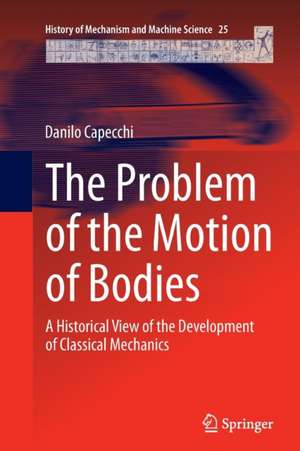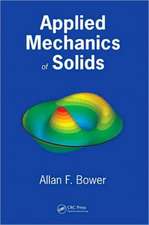The Problem of the Motion of Bodies: A Historical View of the Development of Classical Mechanics: History of Mechanism and Machine Science, cartea 25
Autor Danilo Capecchien Limba Engleză Paperback – 3 sep 2016
| Toate formatele și edițiile | Preț | Express |
|---|---|---|
| Paperback (1) | 957.32 lei 6-8 săpt. | |
| Springer International Publishing – 3 sep 2016 | 957.32 lei 6-8 săpt. | |
| Hardback (1) | 963.60 lei 6-8 săpt. | |
| Springer International Publishing – 11 iul 2014 | 963.60 lei 6-8 săpt. |
Din seria History of Mechanism and Machine Science
- 15%
 Preț: 647.40 lei
Preț: 647.40 lei - 15%
 Preț: 666.73 lei
Preț: 666.73 lei - 18%
 Preț: 1018.55 lei
Preț: 1018.55 lei - 20%
 Preț: 752.94 lei
Preț: 752.94 lei - 18%
 Preț: 1002.61 lei
Preț: 1002.61 lei - 18%
 Preț: 950.52 lei
Preț: 950.52 lei - 18%
 Preț: 735.84 lei
Preț: 735.84 lei - 15%
 Preț: 649.54 lei
Preț: 649.54 lei - 15%
 Preț: 637.46 lei
Preț: 637.46 lei - 18%
 Preț: 1227.67 lei
Preț: 1227.67 lei - 15%
 Preț: 633.35 lei
Preț: 633.35 lei -
 Preț: 384.31 lei
Preț: 384.31 lei - 15%
 Preț: 655.92 lei
Preț: 655.92 lei -
 Preț: 389.70 lei
Preț: 389.70 lei - 15%
 Preț: 644.82 lei
Preț: 644.82 lei - 18%
 Preț: 954.45 lei
Preț: 954.45 lei -
 Preț: 442.13 lei
Preț: 442.13 lei - 20%
 Preț: 576.88 lei
Preț: 576.88 lei - 18%
 Preț: 944.19 lei
Preț: 944.19 lei - 24%
 Preț: 788.01 lei
Preț: 788.01 lei - 15%
 Preț: 647.73 lei
Preț: 647.73 lei - 15%
 Preț: 645.28 lei
Preț: 645.28 lei - 18%
 Preț: 963.60 lei
Preț: 963.60 lei - 18%
 Preț: 967.08 lei
Preț: 967.08 lei - 15%
 Preț: 645.28 lei
Preț: 645.28 lei -
 Preț: 399.29 lei
Preț: 399.29 lei - 15%
 Preț: 644.82 lei
Preț: 644.82 lei - 20%
 Preț: 594.05 lei
Preț: 594.05 lei - 15%
 Preț: 645.28 lei
Preț: 645.28 lei
Preț: 957.32 lei
Preț vechi: 1167.45 lei
-18% Nou
Puncte Express: 1436
Preț estimativ în valută:
183.21€ • 190.56$ • 151.25£
183.21€ • 190.56$ • 151.25£
Carte tipărită la comandă
Livrare economică 15-29 aprilie
Preluare comenzi: 021 569.72.76
Specificații
ISBN-13: 9783319343631
ISBN-10: 3319343637
Pagini: 566
Ilustrații: XII, 554 p. 83 illus.
Dimensiuni: 155 x 235 x 29 mm
Greutate: 0.79 kg
Ediția:Softcover reprint of the original 1st ed. 2014
Editura: Springer International Publishing
Colecția Springer
Seria History of Mechanism and Machine Science
Locul publicării:Cham, Switzerland
ISBN-10: 3319343637
Pagini: 566
Ilustrații: XII, 554 p. 83 illus.
Dimensiuni: 155 x 235 x 29 mm
Greutate: 0.79 kg
Ediția:Softcover reprint of the original 1st ed. 2014
Editura: Springer International Publishing
Colecția Springer
Seria History of Mechanism and Machine Science
Locul publicării:Cham, Switzerland
Cuprins
The Science of Motion sive Mechanics.- Greek Period and Middle Ages.- Humanism and Renaissance.- Early Modern Studies on Motion.- The Golden Age.- The Motion of Solid Bodies.- Inanimate Bodies Start Moving by Themselves.
Recenzii
“This is a very interesting volume for all scholars of mechanics interested in the roots of the basic question of their discipline … . the book is surely a very powerful tool for anyone interested in the basics of mechanics when seeking answers to questions on the subject.” (Giuseppe Claudio Rata, Mathematical Reviews, March, 2017)
“This work, part of the ‘History of Mechanism and Machine Science’ series, looks at the development of the physics of motion through six periods: classical-Hellenistic, Middle Ages, early Renaissance, the age of Galileo and Descartes, Newton’s (golden) age, and the 18th century. … a very interesting and illuminating read. Summing Up: Highly recommended. Upper-division undergraduates, graduate students and researchers/faculty.” (E. Kincanon, Choice, Vol. 52 (6), February, 2015)
“This work, part of the ‘History of Mechanism and Machine Science’ series, looks at the development of the physics of motion through six periods: classical-Hellenistic, Middle Ages, early Renaissance, the age of Galileo and Descartes, Newton’s (golden) age, and the 18th century. … a very interesting and illuminating read. Summing Up: Highly recommended. Upper-division undergraduates, graduate students and researchers/faculty.” (E. Kincanon, Choice, Vol. 52 (6), February, 2015)
Notă biografică
Danilo Capecchi is Professor of Mechanics of Solids and History of Science at the University of Rome La Sapienza. His research into the history of science focuses mainly on classical mechanics.
Textul de pe ultima copertă
This book focuses on the way in which the problem of the motion of bodies has been viewed and approached over the course of human history. It is not another traditional history of mechanics but rather aims to enable the reader to fully understand the deeper ideas that inspired men, first in attempting to understand the mechanisms of motion and then in formulating theories with predictive as well as explanatory value. Given this objective, certain parts of the history of mechanics are neglected, such as fluid mechanics, statics, and astronomy after Newton. On the other hand, due attention is paid, for example, to the history of thermodynamics, which has its own particular point of view on motion. Inspired in part by historical epistemology, the book examines the various views and theories of a given historical period (synchronic analysis) and then makes comparisons between different periods (diachronic analysis). In each period, one or two of the most meaningful contributions are selected for particular attention, instead of presenting a long inventory of scientific achievements.
Caracteristici
Comprehensive coverage of approaches to the problem of the motion of bodies over the course of human history Includes numerous original quotations Adopts a modern historical approach to the topic Includes supplementary material: sn.pub/extras








